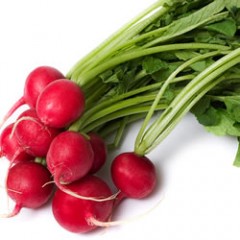Radishes
 Approximately 154 acres are produced on 57 farms (2007 Census of Ag) in New York. They are harvested from May through September.
Approximately 154 acres are produced on 57 farms (2007 Census of Ag) in New York. They are harvested from May through September.Radishes come in many shapes, sizes and colors. Small round types are popular for salads. Radishes with long roots, including daikon varieties are a popular ethnic vegetable that can be eaten fresh or cooked in a variety of ways.
Relevant Events
2025 Potato Advisory Meeting
December 16, 2025
Canandaigua, NY
2026 Finger Lakes Produce Auction Winter Growers Meeting
January 8, 2026
Penn Yan, NY
Cabbage Maggot Control in Brassicas, 2024
Christy Hoepting, Extension Vegetable Specialist
Cornell Vegetable Program

Since the brassica industry's go-to for cheap, easy and effective control of cabbage maggot, Lorsban along with its generic products (active ingredient chlorpyrifos) was banned in 2021, Brian Nault (Cornell Entomology) and Cornell Vegetable Program Specialist Christy Hoepting have been conducting cabbage maggot trials annually from 2021 to 2023 in search of an effective and affordable alternative. Read our key findings and the 2024 Cornell "Cheat Sheet" for Insecticide Options for Cabbage Maggot in Brassicas in New York.
Video: New York State Produce Auctions

Currently, there are 8 produce auctions in New York State. These auctions are aggregation points that allow local farmers to sell their produce in wholesale lots to buyers from across the region. To document the economic impact of produce auctions on agriculture, local businesses, family farms, and produce buyers, the Cornell Vegetable Program worked with Harvest New York to survey top sellers and buyers.
A new Cornell Vegetable Program video shares general information about produce auctions, how buyers and sellers use the auctions to expand their businesses, and how local communities benefit from them.
Crop Cooling and Storage
Robert Hadad, Extension Vegetable Specialist
Cornell Vegetable Program

On-Farm Cold Storage of Fall-Harvested Fruit and Vegetable Crops is an in-depth look at the planning and designing cooling for late season and winter storage but it also is useful for general cooling as well. This was written by Scott Sanford, Distinguished Outreach Specialist, UW-Extension, and John Hendrickson, Outreach Program Manager, Center for Integrated Agricultural Systems, University of Wisconsin-Madison.
Video: Produce Washing Stations - How to Use a Germicidal Bleach

Good Agricultural Practices or GAPs are the steps taken in produce packing areas to reduce microbial contamination. One area where reducing micro contamination is critical is in the washing and cleaning of produce. This video shows you a set of standard operating procedures for using a germicidal bleach in a produce washing station. Learn what supplies are required and how to calculate the amount of germicidal bleach needed to sanitize the water.
Winter Aphid Management Fact Sheet
Cordelia Machanoff, Program Aide
Cornell Vegetable Program

Aphids can be a major problem in winter greens. This fact sheet outlines our experience with biological and biorational controls over four years of field research.
Extending the Harvest Season with Fall Production
Robert Hadad, Extension Vegetable Specialist
Cornell Vegetable Program

Late season production starts in mid spring. For a successful crop, start with a detailed plan. Designate an area specific for late season production so that management can take place in one spot rather than all over the farm. This will make cultivation, pest management, using row cover, and harvesting more efficient to manage.
O-zone Injury on Vegetables
Crystal Stewart-Courtens, Extension Vegetable Specialist
Eastern New York Commercial Horticulture

Hot, humid weather with stagnant air masses may lead to ozone damage on crops. Ozone warnings were recently issued for much of New York. These warnings are intended for people with respiratory problems and let them know they should limit their outdoor activity and try to stay as much as possible in air-conditioned locations. These warning are also a good indicator that ozone damage may occur in plants.

Upcoming Events
2025 Potato Advisory Meeting
December 16, 2025
Canandaigua, NY
Come hear the latest on insect pest control and fertility management in potatoes from Cornell University experts. Potato variety trial updates will be shared too. After lunch will be the Empire State Potato Grower's Meeting. 1.5 DEC credits in 10, 1a, and 23.
2026 Finger Lakes Produce Auction Winter Growers Meeting
January 8, 2026
Penn Yan, NY
At this vegetable grower-focused meeting, ag industry experts will discuss food safety, disease management in strawberries, the benefits of using cover crops, plus more. Two grower panel discussions will focus on pest management techniques and irrigation. DEC recertification credits offered in categories 10, 1a, 21, 22, 23, and 24.


































